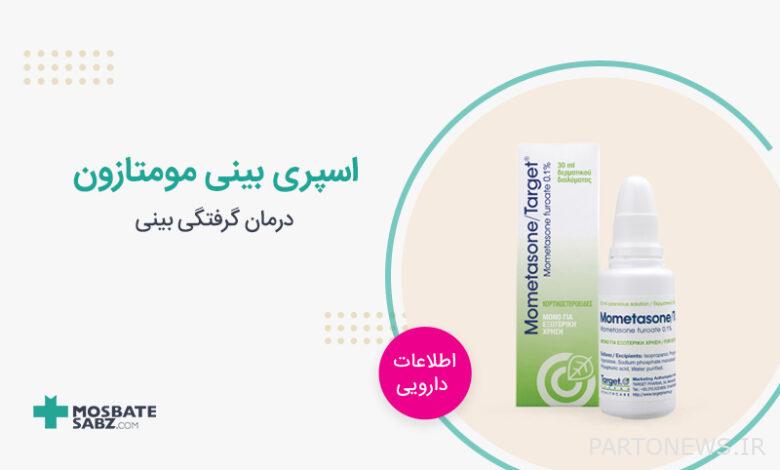Mometasone nasal spray, benefits and side effects of Mometasone inhaled drug

Mometasone nasal spray belongs to the group of anti-allergic steroid drugs that are injected directly or accidentally into the nasal area and play a role in reducing inflammation and swelling in this area. Having anti-inflammatory, anti-allergic and inhibitory effects on the production of histamine, an important factor in allergies, this drug has been able to play a role in the effective management of symptoms related to diseases caused by allergic reactions. In the following, we will examine the mechanism of action, pharmaceutical forms, indications for use, amount and time of use, precautions and contraindications for the use of inhaled mometasone.
What we read in this article
Pharmaceutical forms of mometasone
- Powder for inhalation (Asmanex Twisthaler): 100 mg/active and 200 mg/active
- Metered-dose inhalation (Asmanex HFA): 50 μg/active, 100 μg/active and 200 μg/active
Uses of mometasone nasal spray
This medicine is used to treat skin diseases such as eczema, psoriasis, allergies and skin rashes. Mometasone reduces swelling (inflammation), itching, and redness and is a moderate-strength corticosteroid. This medicine is available in different forms, including cream, ointment and lotion (solution). Your doctor will choose the type of medicine based on the condition of the skin and the area of the body being treated.
- The biggest changes that will happen in WhatsApp this yearFebruary 3, 2024
- Applications for locating family and friends on AndroidFebruary 2, 2024
Pharmacological effects and mechanism of action of inhaled mometasone drug
Corticosteroid with strong anti-inflammatory properties; It affects various cells including mast cells and eosinophils. It also affects inflammatory mediators (such as histamine, eicosanoids, leukotrienes, cytokines). This drug is 98-99% protein bound and metabolized in the liver by CYP3A4.
The dosage of mometasone inhaled medicine
Mometasone nasal spray, as the name suggests, is made for the nose, but it is also used by some doctors on various internal parts of the body. Do not use this medication on the face, groin, armpits, or diaper rash unless directed by your doctor. Before use, wash and dry your hands, then clean and dry the affected area and apply the medicine to the desired area in an appropriate amount or according to the prescription. Do not cover the treated area with bandages or other dressings unless directed to do so by your doctor.
When to use mometasone nasal spray
Before using mometasone nasal spray, check the drug information on the drug package, including the amount and time of use. Wash your hands after using this medicine unless you are using this medicine to treat your hands. If inflammation or redness occurs after accidentally getting this spray into the eyes, wash your eyes. If the side effects (including redness, itching, tears, etc.) do not decrease after washing, see a doctor. Use the medicine according to the doctor’s prescription, increasing the dosage will not increase the speed of your recovery and will only cause side effects.
How to use mometasone nasal spray in adults
- How to use Asmanex Twisthaler: Mometasone nasal spray is recommended for the maintenance treatment of asthma as a preventive treatment.
- Receiving bronchodilators alone or inhaled corticosteroids: 220 mcg of the spray once daily in the evening, which may be increased to 220 mcg every 12 hours if needed.
- Corticosteroids: Take 440 micrograms orally (by inhalation) every 12 hours. Do not exceed 880 micrograms per day.
- The dosage for Asmanex HFA forms is 2 inhalations every 12 hours (ie, 200-400 mcg/12 hours), with the starting dose based on previous asthma treatment.
- Patients not using inhaled corticosteroids: 200 mcg every 12 hours by inhalation (as 2 movements of 100 mcg per actuation).
- Currently taking oral corticosteroids: 400 mcg every 12 hours orally by inhalation (as 2 boosts of 200 mcg/boost). Failure to respond to initial dose after 2 weeks: dose escalation may provide additional asthma control. The maximum recommended daily dose is 200 micrograms by inhalation every 12 hours (as 2 movements of 200 micrograms/stimulation). It should be noted that the total amount should not exceed 800 micrograms per day.
How to use mometasone nasal spray in children
- Pharmaceutical forms of Asmanex Twisthaler, the dosage for children 4-11 years old is 110 micrograms by inhalation once a day in the evening, and the total amount should not exceed 110 micrograms per day.
- Have received bronchodilators alone or inhaled corticosteroids: For people over 12 years of age, 220 mcg orally once daily in the evening, which may be increased to 220 mcg every 12 hours if needed.
- Corticosteroids: 440 micrograms inhaled every 12 hours not to exceed 880 micrograms per day.
- The dosage of Asmanex HFA forms in children 5 to 12 years old is 100 mcg every 12 hours by inhalation (as 2 movements of 50 mcg per inhalation), the total amount should not exceed 200 mcg per day. Also, people over 12 years of age use 2 inhalations every 12 hours (that is, 200-400 micrograms per 12 hours), and the starting dose is based on previous asthma treatment.
- Patients not using inhaled corticosteroids: Use 200 mcg by inhalation every 12 hours (as 2 actuations of 100 mcg per actuation).
- Oral corticosteroids: 400 mcg every 12 hours by inhalation (as 2 times 200 mcg/stimulation).
- Failure to respond to initial dose after 2 weeks: dose escalation may provide additional asthma control. The maximum recommended daily dose is 200 micrograms by inhalation every 12 hours (as 2 movements of 200 micrograms/stimulation).
Precautions
Before taking Mometasone, if you are allergic to it or other ingredients in the drug, avoid using it. This medicine may contain inactive ingredients that can cause allergic reactions or other problems. If you have medical records such as poor blood circulation, diabetes, immune system problems, liver disorders, lung disorders, heart problems, respiratory problems, etc., consult your doctor regarding the use and risks of this medicine. Corticosteroids can make skin infections worse and more difficult to treat. Tell your doctor if you have a skin infection so it can be treated.
- Mometasone is not a bronchodilator; Not recommended for rapid relief of bronchospasm or other acute episodes of asthma. To treat acute asthma symptoms, a short-acting beta2 agonist, such as albuterol, should always be available. Instruct patients to contact their physician immediately if asthma episodes do not respond to bronchodilators during treatment. During such periods, patients may require treatment with oral corticosteroids.
- Reactivation of allergic conditions previously suppressed by systemic corticosteroids may occur after transition from systemic corticosteroid therapy.
- Respiratory tuberculosis, untreated fungal or bacterial infections, viral or parasitic infections, ocular herpes simplex have been reported.
- Cataracts, glaucoma, increased intraocular pressure have been reported. Consider referral to an ophthalmologist in patients with ocular symptoms or long-term therapy.
- A risk of a more serious or fatal course of chickenpox and measles has been reported in susceptible individuals. Avoid use in unvaccinated or immunologically compromised children or adults.
- Deaths from adrenal insufficiency have occurred after abrupt discontinuation of oral steroids.
- Overuse may suppress hypothalamic-pituitary-adrenal function.
- During periods of stress or severe asthma, the patient may require immediate adjunctive systemic corticosteroids. Carry the warning card for this purpose.
- Long-term consumption reduces bone mineral density.
Warning of fungal infections
- Local infections of the mouth and pharynx with Candida albicans have been reported. If oropharyngeal candidiasis develops, treat with appropriate topical or systemic (eg, oral) antifungal therapy while continuing therapy. Sometimes treatment may also need to be stopped.
- To reduce the risk of oropharyngeal candidiasis, advise patients to rinse their mouth with water after taking the drug and remove it from their mouth without swallowing.
Mometasone contraindications
- Hypersensitivity
- Immunosuppressed patients
- Tuberculosis
- Status asthmaticus or other acute episodes of asthma that require intensive measures.
- Known hypersensitivity to milk proteins or any other substance
Side effects of mometasone (mometasone inhaled)
Burning, itching, inflammation, viral infection, headache, cough, etc. are some of the side effects of mometasone nasal spray. If any of these effects persist or worsen, tell your doctor or pharmacist right away. Most people who use this drug do not experience serious side effects. Some of the serious side effects of this drug include stretch marks, thinning and discoloration of the skin, acne, small red bumps on the skin (folliculitis), etc. This drug is absorbed into the blood through the skin, which can lead to the side effects of too much corticosteroid.
- Headache
- Viral infection
- pharyngitis
- Epistaxis
- Cough
- Upper respiratory tract infection
- dysmenorrhea
- Loss of taste
- Muscular pain
- Vision blurred

Mometasone drug interactions
- Major interactions: bemiparin, cobicistat, macimorelin, nadroparin, nirmatelvir, ritonavir, sargramostim
- Moderate interactions: atazanavir, aranofin, clarithromycin, glycerol phenylbutyrate, indinavir, insulin (types), ketoconazole, nefazodone, nelfinavir, saquinavir, telithromycin, testosterone (types)
- Increased effectiveness of drugs by mometasone: desmopressin, logzapine
- Reducing the effects of drugs by mometasone: aldesloquine, cosinetropin, sketamine (nasal)
Use of mometasone nasal spray (mometasone inhaled) during pregnancy and breastfeeding
Mometasone nasal spray is in group C in terms of risk during pregnancy. That is, it can be used under the supervision and examination of a doctor. Animal studies have shown some adverse effects on the fetus, and specific human studies are not available. The benefits of the drug against possible risks determine whether or not to use this drug during pregnancy.
Animal studies of mometasone
- In animal reproduction studies with pregnant rats or rabbits, mometasone furoate increased fetal malformations and decreased fetal survival and growth following administration of doses that were 1.3 to 8 times the maximum recommended human dose (MRHD) in mcg. Was.
- However, experience with oral corticosteroids suggests that rodents are more susceptible to teratogenic and corticosteroid effects than humans.
- In women with poorly or moderately controlled asthma, there is an increased risk of several adverse perinatal outcomes such as preeclampsia in the mother, prematurity, low birth weight, and small for gestational age in the infant.
- Monitor pregnant women with asthma closely and adjust medication as necessary to maintain optimal asthma control.
The effect of mometasone on breastfeeding
There is no information on the presence of mometasone in human milk, its effects on the nursing infant, or its effects on milk production. Other inhaled corticosteroids, such as mometasone furoate, are present in human milk. Consider the developmental and health benefits of breastfeeding along with the mother’s clinical need and any possible adverse effects on the infant, resulting from mometasone inhalation or the mother’s underlying medical condition.
Storage conditions for mometasone inhaled medicine
Mometasone nasal spray should be stored at room temperature. Note that all chemicals should be kept out of the reach of animals and children.
The last word of mometasone nasal spray
In this article from Positive Green Pharmacy magazine, we investigated mometasone nasal spray as an effective tool in the management of diseases caused by respiratory disorders. This medicine provides anti-inflammatory, anti-allergic and histamine production inhibiting effects in the nasal area with its unique combination. The positive effects of this drug in reducing inflammation and swelling have improved symptoms caused by allergies and other respiratory problems. Since this drug is often recognized as an effective and safe treatment, it can be a good option for controlling patients’ symptoms.
Site source: Medscape

